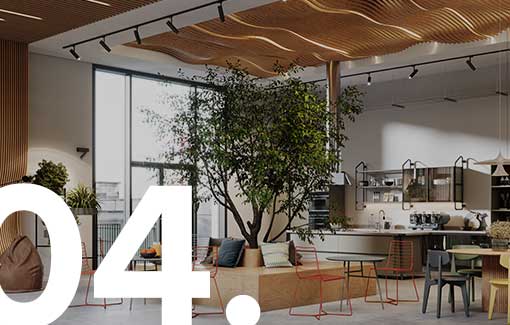
How Engineers are Using Electric Heat to Improve IAQ
Traditionally, HVAC systems were designed first with thermal comfort in mind, then efficiency, but not air quality. Single pane windows changed to double pane, insulation was blown into walls and built into new structures, and, in general, buildings were designed to be more airtight to increase comfort and decrease heat and energy losses. While getting rid of drafty doors led to more comfortable spaces and less stress on HVAC systems, it also led to poor air quality in buildings. In modern structures, most of the air you breathe inside is the same air used to heat and cool that space. This air contains allergens, viral particles, dusts, molds, carpet fibers, and other detritus. The consequence of this is that most buildings in the United States have moderately efficient and effective heating and cooling that causes poor indoor air quality (IAQ) and leads to related air quality health issues and conditions such as allergies and bacterial and viral illnesses. Engineers of the IAQ HVAC industry now find themselves faced with a new task: meeting the demand for commercial and residential indoor air quality products and system designs that improve IAQ. As a result of the COVID-19 pandemic, IAQ is at the forefront of concern for homeowners and business owners alike. People are spending more time in their residences than ever before and considering the impact air quality has on their health and the health of their families. Business owners are investing in IAQ improvement measures in hopes of attracting and retaining customers who have been avoiding entering brick-and-mortars out of concerns about viral exposure.
“Because of COVID-19, business owners are evaluating the true expenses of poorly ventilated spaces and subpar HVAC systems.”
But why be concerned about air quality now? Well, aside from negative health implications alone, the cost of poor air quality is high. Because of COVID-19, business owners are evaluating the true expenses of poorly ventilated spaces and subpar HVAC systems. Making an initial investment in HVAC that offers improved IAQ can be painful but worth it when employees are not missing weeks due to air quality issues in the workplace and buildings are not sitting empty while the staff works from home. The simplest way for engineers to improve IAQ is to bring more outdoor air inside. There are several different methods they employ to do this, from designing windows that open to installing whole-building purification systems. However, it may be time to consider a new an alternative method: vertical unidirectional airflow (UDF) ventilation.
In standard HVAC systems, called Mixing Ventilation or TMV systems. Viral particles and other contaminants can remain airborne for over 40 hours, causing an inherent risk of viral transmission. Traditional TMV ventilation with proper filtration can reduce the risk of viral transmission, but unfortunately, it is proven that even a filtration level of MERV 14 is not totally effective at removing COVID-19. In addition, the stress effected on a system with MERV 14 would be substantial. Fortunately, changing the heating profile creates the opportunity to improve air quality. Unidirectional airflow ventilation makes air flow vertically, from ceiling to floor. Already in use in hospitals across the United States, research shows that UDF ventilation leads to the reduction of airborne viral spread caused by cooling systems. However, if the ventilation system is designed properly and paired with Radiant Electric Heat’s (REH) infrared electric heating panels, it will also improve IAQ with heating systems by reducing turbidity.
The simplest way for engineers to improve IAQ is to bring more outdoor air inside. There are several different methods they employ to do this, from designing windows that open to installing whole-building purification systems. However, it may be time to consider a new an alternative method: vertical unidirectional airflow (UDF) ventilation.
In standard HVAC systems, called Mixing Ventilation or TMV systems. Viral particles and other contaminants can remain airborne for over 40 hours, causing an inherent risk of viral transmission. Traditional TMV ventilation with proper filtration can reduce the risk of viral transmission, but unfortunately, it is proven that even a filtration level of MERV 14 is not totally effective at removing COVID-19. In addition, the stress effected on a system with MERV 14 would be substantial. Fortunately, changing the heating profile creates the opportunity to improve air quality. Unidirectional airflow ventilation makes air flow vertically, from ceiling to floor. Already in use in hospitals across the United States, research shows that UDF ventilation leads to the reduction of airborne viral spread caused by cooling systems. However, if the ventilation system is designed properly and paired with Radiant Electric Heat’s (REH) infrared electric heating panels, it will also improve IAQ with heating systems by reducing turbidity.

“Radiant Electric Heat’s panels cause no air movement, nor do they rely on air as the vehicle for heat delivery.”
Radiant Electric Heat’s panels cause no air movement, nor do they rely on air as the vehicle for heat delivery. They are not self-ventilating, but they do not need to be. They generate no emissions, experience no heat or energy loss in production, and can be operated only when needed—and when there is need, they bring a room to the desired comfort level in minutes. CeramiCircuit™ technology allows REH’s panels to provide direct heat from the heating units to the occupants in the space where they are installed. Radiant Electric Heat’s panels are simple, safe, and functional units that can be installed anywhere indoors, including in the ceiling where they are nearly invisible. They are the perfect complement to ventilation systems whose purpose is to keep air free of contaminants, as they add none. The combination of UDF ventilation and REH’s electric heat panels creates a space whose air is clean and comfortable. This system design can be used anywhere, in retail stores, office buildings, or restaurants, keeping customers focused on working, shopping, or the food they want to order as opposed to the illness they may contract while eating it. School classrooms are also an ideal application. Sadly, many of today’s children attend school in classrooms devoid of any ventilation other than an open window. Using downward UDF ventilation with overhead radiant heating provides a simple but overlooked solution to a long-standing problem that has only recently surfaced and impacts humans’ most valuable possession: our health.Related Articles
Electricity plays a major role in the push for dependence on renewable energy and the development of net zero energy buildings. Radiant heating systems are electrically powered and nullify the need for traditional energy sources. They are instrumental to adaptation and renewable sources of energy.
- Electricity: Cleaner, more efficient comfort
- The benefits and pitfalls of VRF system HVAC
- Direct source-to-object heating solutions
VRF system HVAC is considered the top-of-the-line setup for electric heating and cooling—until the temperature drops. Cold climates impair VRF system functionality. Fortunately, there are some simple ways to boost the performance of VRF systems in commercial buildings and other structures.
- Recent advances that make VRF the best electric HVAC option
- Cold weather: The VRF Achilles heel
- The best heat pump supplements
There’s more than heat to consider when creating a comfortable environment. A different balance of heating, cooling, air flow, ventilation, and more is necessary for the comfort of every person in a space. Including radiant panels in traditional or VRF system HVAC makes it possible to deliver individualized comfort to all.
- Alternatives to fossil fuel sourced HVAC systems
- Breakthroughs in radiant heating technology
- Zoning for comfort and conservation


